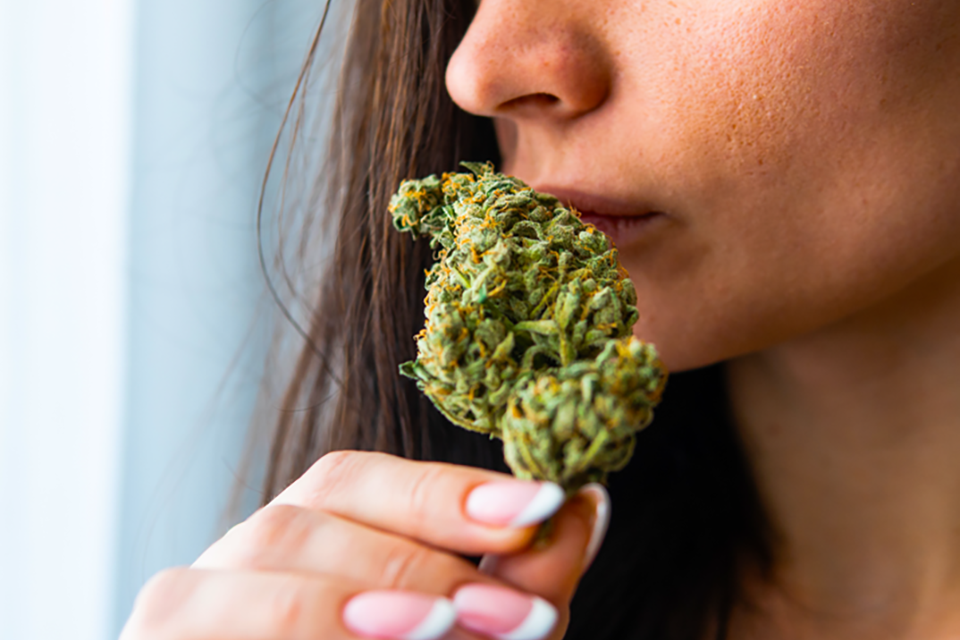
As a grower, there’s nothing more disheartening than seeing a once-beautiful crop wither away, losing all its flavor and fragrance. Rather, every cultivator aims to produce the most potent, aromatic, and flavorful plants.
Of course, genetics and environmental factors are the greatest determinants of your plants’ final taste and smell. But cultivation practices also have a substantial impact on its flavor and aroma.
Among these practices, the choice of growing medium and fertilizer regimen can significantly affect the final product. Thus, it’s essential to understand how different growing methods impact the plant’s sensory qualities.
Why Do Cannabis Plants Smell?
Cannabis plants are known for their intriguing and intricate scents. But what gives cannabis its distinct aroma? The answer lies in a group of special hydrocarbons known as terpenes.
Terpenes are the largest, most diverse group of naturally occurring organic compounds, with more than 30,000 forms. These compounds are ubiquitous and found in plants all around us. They’re the primary component of plant’s essential oils and are responsible for the distinct and diverse flavors and aromas we encounter daily.
A broad scope of terpenes exists in many popular cannabis strains of the industry, and they are not just responsible for their pleasant aroma. Like how natural fruits and flowers impact our mood, these compounds can also increase our energy, induce relaxation and meditation, and promote overall well-being.
Thus, focusing on growing media and fertilizers is paramount to achieving sugar-coated buds that deliver overriding and spicy aromas.
The Impact of Growing Media, Supplements, and Fertilizers on The Smell and Taste of Weed
Your choice of media and fertilizer can impact the smell and taste of your produce. Therefore, it’s important that you understand the relationship between media, fertilizer, and the sensory properties of cannabis to optimize their cultivation practices.
That said, here’s all you need to know:
Grow Medium
The growing medium can significantly affect the final product’s taste. This is because the plant roots absorb nutrients from here, which often end up in the plant’s leaves, flowers, and buds. Therefore, the quality and composition of the growing medium can directly influence the taste of the cannabis.
For instance, hydroponic systems, where plants grow in a water-based solution, can produce cannabis with a crisp and clean taste. This happens because the plants receive precise nutrients and are safe from soil-borne pathogens or contaminants.
On the other hand, cannabis grown in biodiverse, rich soil can achieve a well-expressed and nuanced terpene profile due to the various microorganisms and organic matter therein. A 2018 study has shown that certain PGPRs (plant growth-promoting rhizobacteria) can heighten secondary metabolite production. Placed under optimal growing conditions, microbiologically abundant mediums often deliver complex terpene profiles, explaining the manifold and earthy taste of the final product.
Consequently, you must determine the most effective medium for your genetics. For example, if you have a more sterile potting mix, consider injecting beneficial microbes like Trichoderma spp.
Organic vs. Synthetic Fertilizer
The fertilizer you use can also affect the taste and smell of cannabis plants. Organic enrichers come from natural sources, so they can produce a more compound and intricate flavor and aroma. In contrast, synthetic fertilizers can produce a more one-dimensional taste and smell.
Regardless of your production approach, always avoid excessive fertilizer, as it can harm secondary metabolites. Research suggests that over-feeding crops with nitrogen, for instance, may promote biomass and reduce secondary metabolites. So ensure you balance yield and resin content and identify the sweet spot where both components are at their maximum potential.
Supplements
Sometimes, you only have to change your plants’ diet to elevate their trichome levels. Here’s how different common supplements can help you achieve nice-smelling buds to light up your taste buds.
Molasses
Molasses, a sugary residue obtained during sugar processing, is an excellent source of iron, calcium, magnesium, selenium, copper, and carbohydrates. In addition, the supplement can nourish soil microbes and the plants themselves. To do so, mix 4-5ml of molasses with lukewarm water and apply once or twice weekly during the vegetative phase. Once at the flowering stage, increase the dosage to 8-10ml. This nutrient-rich treat can deliver impressively tasty buds.
Amino Acids
Amino acids, or the building blocks of proteins, are crucial for general plant growth and terpene production. The compound also stimulates the plant’s metabolic processes, ultimately enhancing the synthesis of secondary metabolites like terpenes. Moreover, amino acids can improve the plant’s ability to absorb and utilize nutrients. This results in healthier plants with more robust terpene production, ultimately enhancing the overall taste and smell of cannabis.
Organic supplements
An organic approach involves prioritizing soil health and leveraging natural techniques instead of synthetic ones. To increase your plants’ terpene production, improve soil health through no-till cultivation and helpful microorganisms. Mycorrhizal fungi like Rhizophagus irregularis are especially effective in promoting terpene production, which helps you attain that spicy, floral aroma.
Pesticides
The impact of pesticides on the plant’s aroma and flavor cannot be ignored. Despite their value to growers, these compounds contain dangerous components that could affect your buds’ quality, taste, and aroma. For the most, these ingredients are very aggressive. And since most of today’s substrates contain pesticides, your plants may still consume the dangerous compounds.
After applying pesticides to cannabis plants, the compounds can penetrate the plant tissues and affect the terpenes, directly altering the plant’s unique scent and taste. Pesticide residues are also known to stay on the surface of plants for upwards of 60 days, enough to alter cannabis plants’ flavor and aroma further.
Get Quality Seeds for The Best Weed Aroma and Taste
While fertilizers, growing media, and supplements can greatly determine your plant’s outcome regarding smell and flavor, genetics still stands out among the leading factors determining these attributes. Thus, you cannot overlook the value of beginning with quality clones.
Ultimately, the surest way to achieve your desired outcome is by selecting high-quality cannabis seeds from a reputable company that produces exceptional strains. Fortunately, you’re on the right site.
Kind Seed Co has the right seeds for your growing needs and goals.



